Results 1 to 8 of 8
Thread Information
Users Browsing this Thread
There are currently 1 users browsing this thread. (0 members and 1 guests)
-
02-14-2018, 09:22 PM #1Senior Member

- Join Date
- Jan 2018
- Posts
- 880
Economic Growth In Africa
I will be visiting Ethiopia this year with my family. The industry I am educated in, has literally exploded within the last
two years. Addis Ababa is the capital of Africa due to it being the place where the African Union is headquartered.
https://en.wikipedia.org/wiki/African_Union
China and the US are investing heavily in the continent.
(Yes, there's corruption, violations of human rights and crime.)
-
02-14-2018, 09:41 PM #2Senior Member

- Join Date
- Jan 2012
- Posts
- 4,815
Unfortunate for African wildlife - many species will be extinct shortly - soon only in zoos.
Electronic consumer products, cell phones, etc use the minerals mined from deep in the forest where the remaining gorillas live. They are slow and are "free food". This article is almost 4yrs old already and believe the numbers are down to 700 now. These gorillas live nowhere else on earth.
Conservation
Gorillas are being killed and eaten by miners in the Congo
Fewer than 4,000 Grauer’s gorillas remain and the sub-species is being pushed to extinction by hungry miners
By James Temperton
12 Jul 2016
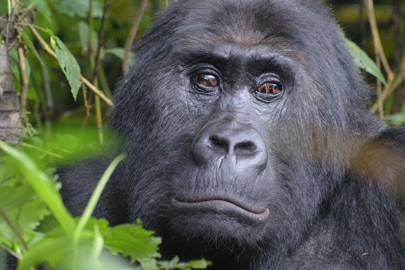
A Grauer’s gorilla silverback male. The gorillas, which live in large groups and move slowly across the ground, are easy pickings for miners working deep in the forest
A.J.Plumptre/WCS
An endangered gorilla subspecies is being pushed towards extinction as mineral miners in the Democratic Republic of Congo (DRC) hunt it for bushmeat. Concerns have now been raised that the global technology supply chain may be accelerating its demise. The Grauer’s gorilla, the world’s largest primate, is only found in the eastern DRC, but decades of illegal hunting and mining, coupled with civil unrest and habitat loss, have pushed it to the brink.
Conservationists are now calling for ‘bushmeat free’ to be included alongside ‘conflict free’ as a way of ensuring minerals used in the global supply chain are sourced from mines that don’t kill endangered animals. According to the Wildlife Conservation Society (WCS), its numbers have fallen 77 per cent in the last two decades, with fewer than 4,000 now remaining.
Its hunting for bushmeat has been driven by the proliferation of small mineral mines deep in the forest, according to Andrew Plumptre, director of the organisation’s Albertine Rift Program, which operates in the DRC, Uganda, Tanzania and Zambia. The mines are usually controlled by armed rebels who work where government forces struggle to reach.
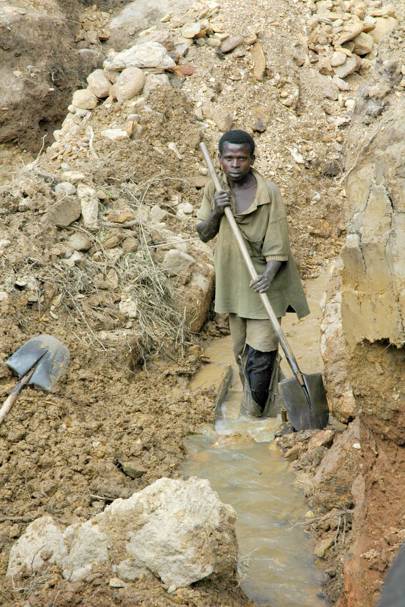 A gold miner working in eastern Democratic Republic of Congo. With little else to eat, miners working in remote areas have been hunting Grauer’s gorillas
A gold miner working in eastern Democratic Republic of Congo. With little else to eat, miners working in remote areas have been hunting Grauer’s gorillas
A.J.Plumptre/WCS
“These mines tend to be located away from where people are, which means they’ve moved deep into the areas where the remaining gorillas tend to be found,” said Plumptre. “And because they’re far from villages they can’t access food very easily and so they tend to hunt around the mines for bushmeat to survive.” Miners who shoot at gorilla groups will almost always be attacked by the silverback as he tries to defend his group. If killed, the absence of a dominant male can cause the group to splinter, putting it at risk of attacks from other males and predators such as leopards.
The WCS is calling on partner organisations and governments to introduce stronger boundaries around protected areas, better-tackle illegal mining, disarm militia groups and find alternative sources of income for local people who depend on the mines. Consumer electronics firms are also being lobbied to only purchase from mines that are bushmeat as well as conflict free.
Despite warnings the gorilla subspecies could go extinct within years, recent efforts to protect pockets of the Grauer’s gorilla population have proved successful. A report released by WCS in June found the population in one part of Kahuzi-Biega National Park had risen from 181 to 213 over a five-year period. The WCS said the success was an encouraging sign and proof that increased investment could save the gorillas.
Grauer's gorillas, which can weigh up to 400 pounds, are closely related to the better-known mountain gorilla. As they live mostly on the ground and in relatively large groups, they can be easily tracked and hunted for bushmeat, Plumptre explained. But for those hunting them, there's little option.
“We’ve found most people don't actually want to mine,” said Plumptre. “They tend to be young men who are trying to raise money for school fees or if there's an emergency and they need medical support for their families.” Finding safe, sustainable alternative employment for locals is key to reducing dependency on mines, according to a WCS report.
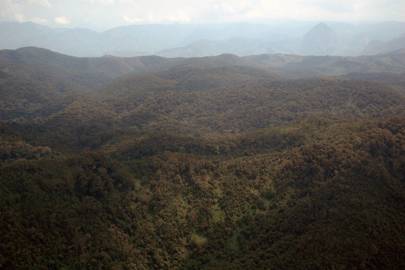
The Kahuzi-Biega National Park in Eastern Congo is one of the last remaining strongholds of the endangered Grauer’s gorilla
A.J.Plumptre/WCS
Getting an accurate picture of the number of small mines operating in the gorillas’ habitat is difficult. “There’s been some decline where people have been moved out, but the government doesn’t maintain a full-time presence,” said Plumptre. However, the WCS has seen a steady rise since 1996. The mines are small and incredibly remote and with no nearby villages or other sources of food, hunting for bushmeat has become increasingly common. And due to their size and the ease with which they can be hunted, the Grauer’s gorillas have become major targets.
According to the WCS, artisanal mining is one of the “primary causes” of the decline in numbers. The mines are mainly producing columbite-tantalite, also known as tantalite or coltan, a mineral used in almost every kind of electronic device. The most commonly-mined conflict minerals in the area make up the 3TG group: tin, tungsten, tantalum and gold ore.
Such minerals are often linked exclusively to the technology sector, but their use is widespread. Jennifer Peyser, senior mediator at Washington, DC-based environmental organisation Resolve, pointed to aerospace, automotive and jewellery as other “very important” sectors. She added that great strides had been made to ensure the global supply chain was conflict free, offering some hope to those striving to save the local gorilla population from hungry miners.
“Six years ago, it was virtually impossible to trace minerals further upstream of the refiner, smelter or metals processor,” said Peyser. “Now, there are systems to track material from validated conflict-free mines all the way through the supply chain.” More than 95 per cent of known tantalum smelters, she continued, are now verified as conflict-free through independent third party audits.
Companies that use such minerals must also be more willing to act on emerging or previously unknown threats to their due diligence processes, Peyser added. More stringent and sophisticated risk mitigation systems would lower the risk of “poaching-related minerals” ending up in supply chains.
Concern over conflict minerals in the DRC has seen a lot of coltan mining shift to Australia, but business in Africa is still booming. In 2014 the British Geological Survey estimated Central African mines contributed nine per cent of global coltan supply.
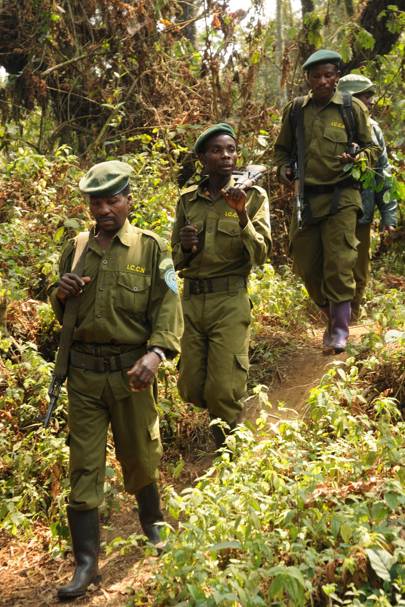
Increased funding and support for boots-on-the-ground work in Eastern Congo can significantly reduce poaching of endangered species, conservationists have said
A.J.Plumptre/WCS
Plumptre said he was “pretty sure” large, well-known electronics companies were producing products containing minerals obtained from mines hunting bushmeat. But tracing back the supply chain, particularly when it comes to minerals obtained from illegal mines that rely on bushmeat, is an arduous task. Minerals from so-called ‘bushmeat mines’ likely make their way through several middlemen in the Rwandan port cities of Bukavu or Goma before spreading out across the world.
“There’s still an international demand for these minerals and many of them are flowing out through Uganda and Rwanda,” added Plumptre. “They can get hidden in whatever exports are going out through those two countries. Even with a certification scheme, which is one of the things we’re proposing, it’s difficult to control because other minerals from other sites can be slipped into the chain.”
While gorilla numbers have been steadily increasing in protected areas, populations elsewhere continue to decline at a rate of about five per cent every year. The WCS is currently lobbying to create two new protected areas in Kahuzi-Biega National Park, which could be run by local communities as an alternative form of employment. But Plumptre has a stark warning for areas that fail to protect gorilla populations.
“At other sites, where there is no protecting going on, it’s unlikely the rate of decline is going to change. We predict that in most of those sites we could lose gorillas in the next five to ten years.”
http://www.wired.co.uk/article/graue...als-technology
-
02-14-2018, 09:47 PM #3
Have a wonderful trip Boomslang.
A Nation Without Borders Is Not A Nation - Ronald Reagan
Save America, Deport Congress! - Judy
Support our FIGHT AGAINST illegal immigration & Amnesty by joining our E-mail Alerts at https://eepurl.com/cktGTn
-
02-14-2018, 10:44 PM #4Senior Member

- Join Date
- Jan 2018
- Posts
- 880
While industry is not perfect, they are beginning to "diversify" their materials as soon ad the bean counters find away to make it cost effective.
Also companies like Dell and Apple have done a lot of recycling; still not perfect, though.
Many computer manufacturers are responsible for the free fall in demand for coltan that was needed in various boards.
Silicon has reached it useful potential. so there is a mad scramble for the next thing.
Enter Germanium. Next generation of chips will be a lot "cleaner" and more durable.
Silicon-germanium alloys are rapidly becoming an important semiconductor material for high-speed integrated circuit.
-
02-14-2018, 10:45 PM #5Senior Member

- Join Date
- Jan 2018
- Posts
- 880
-
02-14-2018, 10:46 PM #6
Oh that would be so wonderful! Thank you!!
 A Nation Without Borders Is Not A Nation - Ronald Reagan
A Nation Without Borders Is Not A Nation - Ronald Reagan
Save America, Deport Congress! - Judy
Support our FIGHT AGAINST illegal immigration & Amnesty by joining our E-mail Alerts at https://eepurl.com/cktGTn
-
02-15-2018, 12:03 AM #7Senior Member

- Join Date
- Jan 2018
- Posts
- 880
Weird fact:
My wife just told me that Africa is covered in swastikas. And it turns out that she is right.
West Africa:
https://selfuni.wordpress.com/2014/1...ikan-swastika/
Why are there Swastika symbols on Lalibela churches in Ethiopia?
/ December 23, 2014

The Swastika and the Suavastika Crosses Alternative names:
Bent Cross
Buddhist Cross
Crooked Cross
Cross Gurgity
Crux Gammata
Fylfot
Gamma Cross
Gammadion Cross
German Cross
Hakaristi
Hakenkreuz
Hakenkruis
Hooked Cross
Khas
Manji
Nazi Cross
Pērkonkrusts
Rotating Cross
Spinning Cross
Suavastika
Swastika
Tetraskelion
Wheel of the Dharma.
Swastika
Swastika
The Suavastika
Suavastika
This is a religious symbol, also used in a secular context.
Being a cross, one of the religions using this symbol was Christianity in the Middle Ages and referred to as a Gammadion, a group of four Greek letter gamma (Γ), the capitalised third letter of the Greek alphabet. Three in a Christian context is a reminder of the Trinity, and each gamma represents one of the four Evangelists, who radiate from the central Greek Cross1, which represents Christ.
Today it is perhaps best recognised as the 1930’s emblem of Adolf Hitler’s extreme-right Nationalsozialistische deutsche Arbeiter-Partei2, commonly known as Nazi. During the Second World War the Swastika was often derisively called the Bent Cross or Crooked Cross3; a slur intended to show that Hitler, an outlaw, was using a Christian cross in a malevolent, non-Christian manner.4
Orientation
http://www.seiyaku.com/customs/crosses/swastika.html

The symbol arrived from Greece via Egypt to Ethiopia. The Greeks themselves inherited the symbol from Armenia. In Armenia it was the ancient symbol of eternity and eternal light (i.e. God). Thus the Agews placed it on the window meaning they had eternal communication or link to God as the window represents “open”.
It’s the right angles of a square meaning truth, rightousness and jestice and they’re equal to 4 90°’s, and when added up they will equal to a full circle 360°’s
East Africa:
Also in the east, swastikas are on churches including the world famous Lalibela church
http://www.ethiopianforeignpolicy.co...s-in-ethiopia/
AFRIKAN SWASTIKA
From the Volta to the Congo to the Nile, from scarification to gold weights to hieroglyphics, the swastika has been used throughout Afriqa for a long time…
When you see hear the word “swastika or see this symbol

what are the first words that come to your mind?
“Nazis.”
“Hitler.”
“Aryans.”
“Blonde hair and blue eyes.”
Then where would you guess these come from?

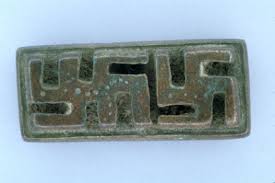
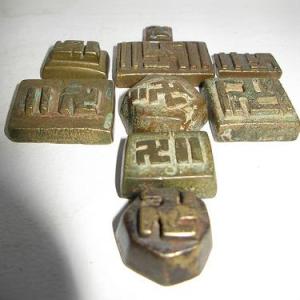
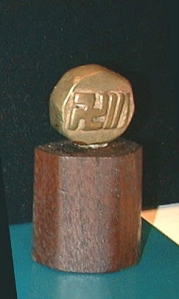
An educated guess would be India. But no, they are all from Africa. That’s right Sub-Saharan, “Black” A-F-R-I-C-A. They are gold dust weights used by the Ashanti, to be more precise.
No, not this Ashanti…

These Ashanti:

The ones who make kinte cloth…

They are also called Akan. The Akan occupy a large part of West Africa including parts of Ghana and the Ivory Coast and include many sub-ethnic groups such as the Baule and the Asante (Ashanti). [1] The Akan were producing them to weigh gold dust which was their currency, thus the name ‘gold weights’. When used on the gold weight, the swastika was a symbol of currency, expressing power, money, wealth and integrity. The idea and the implementation of gold-based currency came from the Akan people of modern-day Côte d’Ivoire and Ghana. [5]
The swastika is also one of the Akan people’s famous Adinkra symbols. Look at number 12 below:
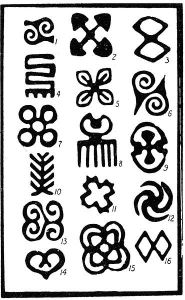
https://at37.wordpress.com/2012/03/2...s-james-gates/According to one source, the swastika is referred to by the Akan as a monkey’s foot. [1] Another source says it is called Kode Emower Ewa (‘talons of the eagle’), represents devotion and service and is shaved on the back of the heads of the Queen Mother’s servants. [2] Still another source names it Nkotimsefuopua, claiming similarly that certain attendants on the Queen Mother who dressed their hair in this fashion. [3]
The Asante also weave the swastika into their cloth. See the top left corner below:
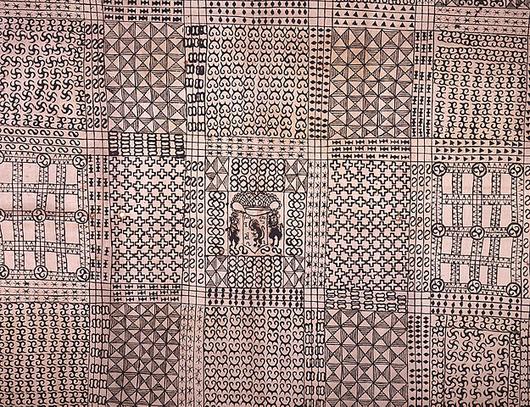
https://at37.wordpress.com/2012/03/2...s-james-gates/
Another Adinkra swastika?The above is a kinte cloth symbol called Apremo-Canon. It is a symbol of resistance against foreign domination, and superior military strategy. This motif represents the superior military strategy with which Akan nations such as the Asante and Akwamu defeated the West Asians who had superior arms. [6]
But how could this be? How did Africans learn about the swastika?
If your idea of swastika is the symbol of a Nordic (tall, blonde, blue-eyed) race who conquered India from the north before invading West Asia (“Europe”), that’s a good question.
The idea is not to decouple the swastika symbol and the Aryans. Rather, one must decouple the Aryan from Nordic, and race from ethnicity.

No signs of a Nordic Aryan invasion here…Arya means pure or good in Sanskrit. In the holy Vedas the good people were called Arya.[2]So “Arya” means, in short, “noble”. It appears to be an adjective, and can not refer to a group of people. If it is a noun, it translates to “nobility” Either way, it refers to the CHARACTER, NOT the APPEARANCE of certain people. Note: The word “Aryan” does not appear.
So how did the word Aryan come into existence, and how did it become associated with a blonde, blue-eyed master race?
Fredrich Max Muller, a staunch German nationalist and Christian missionary, was Professor of Sanskrit at Oxford labored for years translating the Vedas into English.
In 1851 Muller wrote his first article in English wherein he used the word “Aryan” for the first time in the sense of a race.
Max Muller’s good friend and fellow Indologist Paul then popularized the word “Aryan” in France. Soon many Christian scholars were seized upon by the theory of Aryan race. In 1859 Swiss linguist Adolph Pictet wrote that the Aryan race was the
“…one destined by Providence to reign one day supreme ove
r the entire earth . . . They were the race of Aryans. …”
The notion of “Aryan” had become, in a few short years, the emblem of European manifest destiny over the world, a signet coined in the language of scholarship which gave Europeans a racial and religious mantle of superiority.[4]
But the people weren’t fooled. Initially
all attempts to correlate the Aryan language to Aryan race were not only unsuccessful but also absurd”. Even at that time many academics opposed the Aryan invasion theory.[4]So if Aryan refers to a race, it is not a race in the way we usually think of it. “Race” to us means people with the same skin color, culture and language. That is actually ethnicity, though. Ethnicity means related identity, but race means similar qualities. And the people with noble character (‘arya’) can be found all over the world. Maybe they use the same symbols to recognize each other:

Map Showing Distribution of the Swastika – http://www.swastika-info.com/en/historical.php
 The Rockchurch of Lalibela (Ethopia, 12th century) – http://www.proswastika.org/news.php?extend.22.3
The Rockchurch of Lalibela (Ethopia, 12th century) – http://www.proswastika.org/news.php?extend.22.3
 Nekhbet Vulture – By Dynastic Egypt, an extremely wide symbolic lexicon was in use, with the swastika having become a miscellany. (http://aryanism.net/culture/aryan-race/aryan-diffusion-part-5/)
Nekhbet Vulture – By Dynastic Egypt, an extremely wide symbolic lexicon was in use, with the swastika having become a miscellany. (http://aryanism.net/culture/aryan-race/aryan-diffusion-part-5/)
————————————————–
[1] “Nine Cast Brass Gold Dust Weights, Akan People, Ghana, 16th-18th centuries”. Michael Blackman, LTD. Retrieved 10.12.2014 from http://www.michaelbackmanltd.com/1402.html
[2] “Adinkra: Kode Emower Ewa”. About.com. Retrieved 10.12.2014 from http://africanhistory.about.com/libr...Emower-Ewa.htm
[3] R. S. Rattray, Religion and Art in Ashanti (Oxford, 1927), 265. Retrieved 10.12.2014 from https://at37.wordpress.com/2012/03/2...s-james-gates/
[4] Kenyatta, Ekowa. “The Swastika”. The Stewart Synopsis. Retrieved 10.12.2014 from http://www.stewartsynopsis.com/swastika.htm
[5] “Swastika Symbol on Akan gold”. SwastikaShop.com. Retrieved 11.12.2014 from http://swastikashop.com/swastika-symbol-akan-gold/
[6] “Kente Cloth: Ghana’s Ashanti Cultural Heritage to the World’s Fashion Civilization”. Kwekudee- Trip Down Memory Lane. 3.12.2012. Retrieved 11.12.2014 from http://kwekudee-tripdownmemorylane.b...-cultural.html
I learn something new everyday.Last edited by Newmexican; 02-15-2018 at 07:33 AM. Reason: Added articles to outside links
-
02-15-2018, 12:12 AM #8
Wow. How bizarre is that??!!!
A Nation Without Borders Is Not A Nation - Ronald Reagan
Save America, Deport Congress! - Judy
Support our FIGHT AGAINST illegal immigration & Amnesty by joining our E-mail Alerts at https://eepurl.com/cktGTn
Similar Threads
-
Economic growth revised up to 2.5% pace in 3Q
By JohnDoe2 in forum Other Topics News and IssuesReplies: 0Last Post: 11-23-2010, 05:20 PM -
Real Economic GDP Growth, U.S. vs Germany
By AirborneSapper7 in forum Other Topics News and IssuesReplies: 0Last Post: 09-07-2010, 11:18 PM -
U.S. Economic Growth to Slow as Car Rebates End, Survey
By AirborneSapper7 in forum Other Topics News and IssuesReplies: 0Last Post: 09-11-2009, 06:59 PM -
Africa moves one more step toward an EU-like economic union
By Matthewcloseborders in forum Other Topics News and IssuesReplies: 0Last Post: 05-23-2007, 03:41 AM -
Mexico's Economic Growth Likely Quickened in Second Quarter
By Brian503a in forum illegal immigration News Stories & ReportsReplies: 1Last Post: 08-16-2005, 12:44 PM


 4Likes
4Likes LinkBack URL
LinkBack URL About LinkBacks
About LinkBacks




 Reply With Quote
Reply With Quote


Listen to William Gheen on Rense Apr 24, 2024 talking Invasion...
04-25-2024, 02:03 PM in ALIPAC In The News